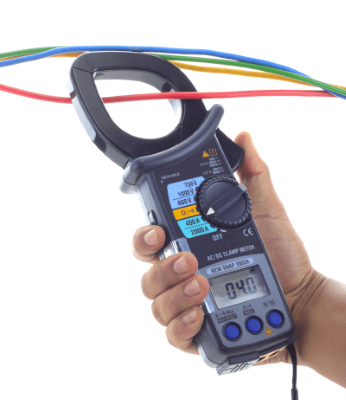What Is a DC Clamp Meter?

A DC clamp meter is a type of clamp meter that measures direct current (DC).
There are also alternating current (AC) clamp meters and dual-use (AC/DC) clamp meters. However, only a limited number of DC-only clamp meters are available, such as for microcurrent measurement. Normally, dual-use AC/DC clamp meters are used to measure DC current.
Clamp meters can measure the current value flowing through the wire of the circuit to be measured by clamping it between the wires. Normally, when measuring the current value, the circuit must be disconnected, and an ammeter inserted, but with a clamp meter, the wire is simply clamped between the heads, making it an easy and safe method.
Uses of DC Clamp Meters
As noted in the previous section, DC clamp meters are used for microcurrent measurement and can handle current measurements from 0.1 mA to 100 mA. On the other hand, general AC and DC clamp meters have a measurement range of 10 mA to 100 A or more, making DC clamp meters suitable for use in semiconductor electronic circuits.
Note that there are no DC clamp meters specifically designed for use in DC high-voltage circuits, and AC/DC clamp meters are used. Since clamp meters measure current without disconnecting the circuit, they are relatively safe to work with, even in high-voltage circuits. They are especially useful for electrical work, as they are extremely convenient.
Principle of DC Clamp Meters
Clamp meters, including DC clamp meters, consist of a clamp section that clamps the wire to be measured and a processing section that converts the strength of the magnetic field detected by the clamp section into a current value and displays it. Normally, when electricity is flowing through a wire, magnetic field lines are generated around the wire. These magnetic field lines are confined in the core of the clamping section.
The clamping section consists of two components: a core made of magnetic material and a means of detecting the magnetic field lines in the core. A part of the core can be split, through which an electric wire is clamped. The core is closed during measurement. The clamps for AC currents are widely used to detect the current flowing through the wire by using the principle of a transformer with a coil wound around the core, but these clamps cannot measure DC currents.
The clamping part that measures DC current is mainly made of a Hall element embedded inside the core. Hall elements use the Hall effect, which outputs a voltage corresponding to the density of magnetic field lines in the core, and thus can measure current even for DC. Hall elements also respond to alternating current, so the current value flowing through the cable can be calculated by measuring its output voltage.
Therefore, clamping parts using Hall elements are mostly compatible with both AC and DC currents, but they have the disadvantage that if the core is magnetized, the effect will cause a large measurement error in the current value. Therefore, it is necessary to remove the residual magnetism of the core periodically. The part of obtaining the current flowing in the wire from the output voltage of the Hall element is handled by the processing section.
Other Information on DC Clamp Meters
How to Use a DC Clamp Meter
1. Clamping Method
Operation of the clamp meter is extremely simple: just clamp the cable on the head. Placing the cable in the center of the head minimizes the measurement error, but even a slight misalignment will not have a significant effect.
2. Direction of Current
When measuring DC current, care must be taken to determine the direction of the current flowing through the cable. The head of a typical clamp meter is marked with a “+” and “-” symbol. This is a guide to indicate the direction of the current. When the DC current flows from “+” to “-“, it is a positive current value, and when it flows from “-” to “+”, it is a negative current value.
3. Leakage Current Measurement
When measuring the current flowing through a device, either the outward or return cable is passed through the head. However, if there is a leakage current inside the device, part of the current flows to ground (earth), resulting in a slightly lower return current than the outward current.
Therefore, measuring the current flowing across the ground wire with a clamp between them can be regarded as leakage current. Since the leakage current is only a few mA to several tens of mA, a clamp meter dedicated to DC measurement is also suitable for this application.